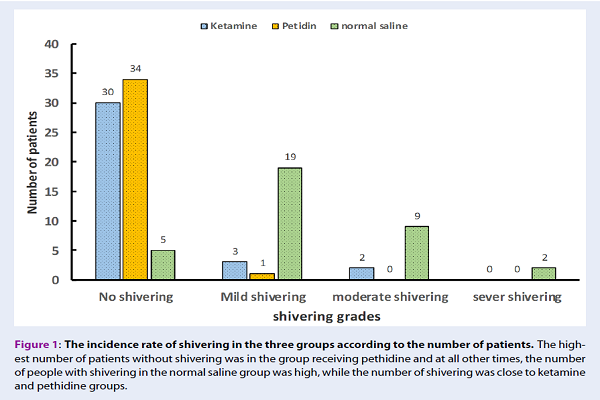Effects of prophylactic ketamine and pethidine to control postanesthetic shivering: A comparative study
DOI:
https://doi.org/10.15419/bmrat.v5i12.508Keywords:
Ketamine, Pethidine, Post-anesthetic ShiveringAbstract
Background: Shivering is an undesirable complication following general anesthesia and spinal anesthesia, whose early control can reduce postoperative metabolic and respiratory complications. Therefore, this study aims to compare the effects of prophylactic injection of ketamine and pethidine on postoperative shivering.
Methods: This double-blind clinical trial was performed on 105 patients with short-term orthopedic and ENT surgery. The patients were randomly divided into three groups; 20 minutes before the end of the surgery, 0.4 mg/kg of pethidine was injected to the first group, 0.5 mg/kg of ketamine was injected to the second group, and normal saline was injected to the third group. After the surgery, the tympanic membrane temperature was measured at 0, 10, 20, and 30 minutes. The shivering was also measured by a four-point grading from zero (no shivering) to four (severe shivering). Data were analyzed by one-way ANOVA, Kruskal Wallis, Chi-square and Pearson correlation.
Results: The mean age of patients was 35.8+/-11.45 years in the ketamine group, 34.8+/-11.64 years in the normal saline group, and 33.11+/-10.5 years in the pethidine group. The one-way ANOVA showed no significant difference in the mean age between the three groups (P=0.645). The incidence and intensity of shivering were significantly higher in the normal saline group than in the ketamine and pethidine groups (p=0.001). However, there was no significant difference in the incidence and the intensity of shivering between the ketamine and the pethidine groups (p=0.936).
Conclusion: The results showed that the 0.5 mg/kg of ketamine could control the post-anesthetic shivering.

Downloads
Published
Issue
Section
License
Copyright The Author(s) 2017. This article is published with open access by BioMedPress. This article is distributed under the terms of the Creative Commons Attribution License (CC-BY 4.0) which permits any use, distribution, and reproduction in any medium, provided the original author(s) and the source are credited.
